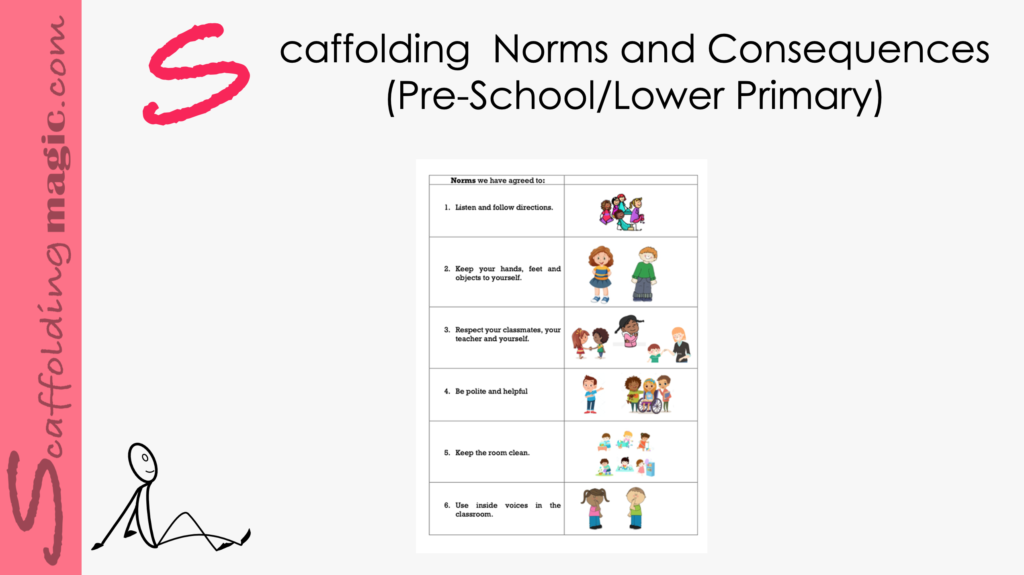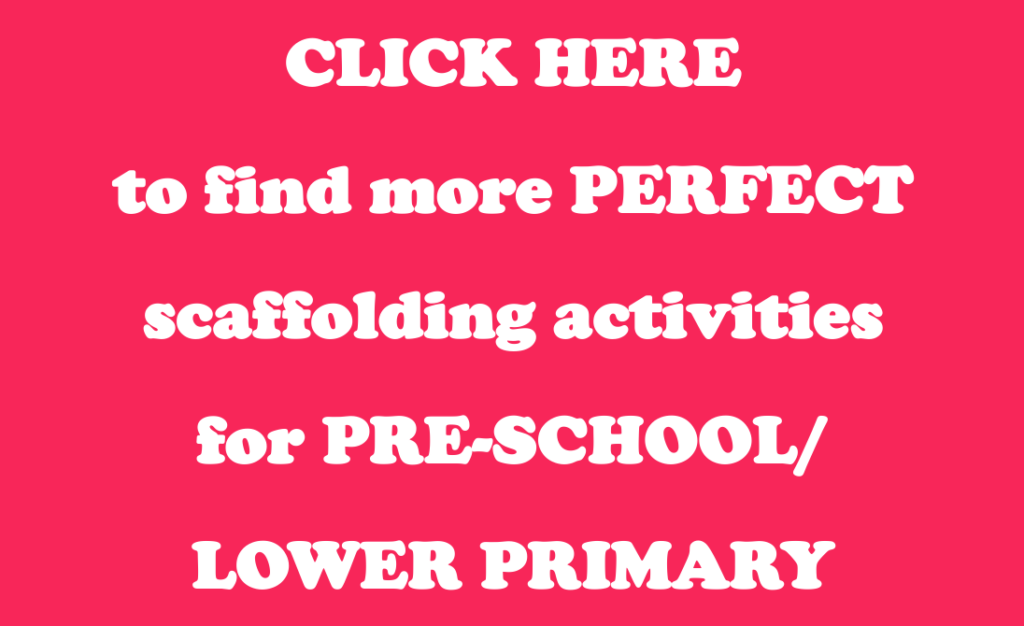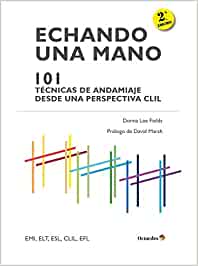You caught a beauty!!!
Download PDF of this scaffold here.
theory behind scaffold…
We’ve planned an incredibly dynamic lesson. We have techniques to lasso (quickly gather) our students into the circle-time area. We have calmed them down with one of our tried-and-true methods. Now what? Why do we still have to spend so much time monitoring inappropriate behaviour? Why is so much of our energy spent on reducing the chaos caused by our young learners just when we begin our sessions?
The answer is simple. As much as we care about our students, and as hard as we work to plan the most effective lessons possible for them, if we aren’t clear and consistent about the norms and consequences for our classes, most of our work is wasted. If we haven’t fortified our learning environment with boundaries and limitations that we have co-created with our students, most of our energy is going to be spent on corralling rambunctious students, instead of presenting new knowledge in exciting ways that will promote assimilation for our young students.
Norms aren’t created to pound our students into submission, and consequences aren’t punishments. Neither are designed to create a controlling environment in which our students have no freedom or choice. On the contrary, they are meant to clarify limits for what is appropriate and what is inappropriate in the classroom. They are meant to show ways to honour ourselves and our classmates by giving us choices that will encourage us to act with empathy, compassion and thoughtfulness. In this way, we are helping our students to have reasons to feel proud of themselves, and for their peers to feel safe when they are with each other. In the end, the compliance with norms, and the acceptance of the consequences if they choose to ignore the former, form a learning environment that is safe and vibrant, and in which students know what is expected of them so that all can move forward.
When should we implement these norms and consequences? The first days of school would be ideal; however, any time of the school year, even in the last weeks, we can implement norms and consequences as solutions for the classroom disruptions that impede daily learning. In doing so, we effectuate dramatic changes that promote the creation of a safe learning environment.
This scaffold is founded on the best educational practices, which include the co-creation of norms and consequences – the underlying goal being to foster more agency even in our youngest learners. The simple list of norms and consequences used in this activity represent a compilation used successfully by Pre-School and Lower Primary teachers around the world. They are most successful when your students take part in confirming and agreeing to them.
There is also an element of collaboration with the parents. If you’re interested in best educational practices presented by the inimitable researcher John Hattie, collective efficacy (when the administration, the principals, the teachers and the parents have the same vision of educational practices used in the classroom), involving the parents is the strongest educational influence we can use.
We encourage you to adopt any or all parts of this scaffold to our needs, and begin – or continue – the year with a strong sense of community and willingness from all by putting the focus on learning and not on constant disciplining.
*(Wong, 2009)
step by step…
- Choose a Lassoing technique
- Choose a Calming Down technique
- Use the set of norms and consequences below to guide you in the activity.
(During various workshops with hundreds of Pre-School teachers, many groups made lists of up to 50 different norms they wanted their young learners to follow. After in-depth discussions, in each case, we were able to simplify the list to the following six (6). Although ostensibly basic, these six norms anticipate and establish virtually all the appropriate behaviours you probably desire during your learning sessions. If you and your students respect them, they will help you to maintain the focus of the classroom on learning and not on inappropriate behaviour.)
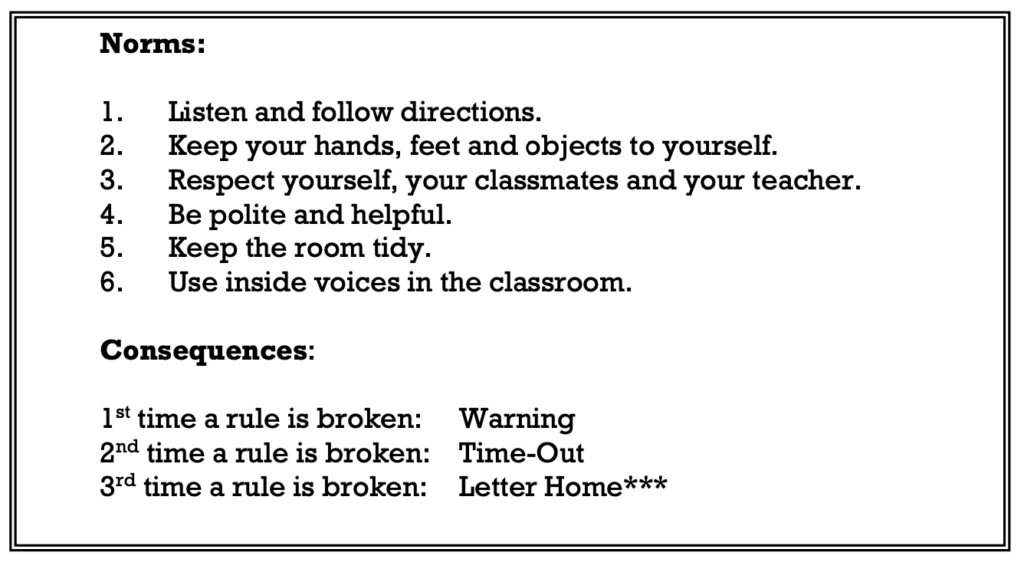
- Continue with the images below (download them here.). Print out a set for each pair of students, and cut them up separately. (You’ll see that the images show healthy and unhealthy practices.)
- Your students use their set of images to find and hold them up as you refer to them. (This brings knowledge closer and more tangible for them.)
- You use a larger set of images to introduce context and vocabulary. The pattern of the dialogue can be the following:
- You hold up an image of children acting respectfully – to themselves, to each other, to the teacher.
- Students find and hold up the same image.
- You identify it and students repeat the term in chorus.
- You ask them to find an image that shows the opposite of this behaviour – children who are not acting respectfully to themselves, to each other, to the teacher.
- You name all the images the students hold up (they are going to hold up a wide variety of images in the beginning!) and students repeat the terms each time in chorus.
- With your students, introduce critical thinking by identifying the opposite of the respectful behaviours you are holding.
- Identify the image and students repeat in chorus.
- Ask two students to model the appropriate and inappropriate behaviour.
- Ask students what makes a safe and strong learning environment.
- Continue this dynamic until you’ve reviewed all the images in a similar way.
- Now, discuss what norms and consequences are (they are not rules and punishments) – the students choose to follow them and so choose the consequence if they don’t. Co-create all of these so as to create a strong and safe learning environment. You can explain that they are all going to agree on six norms, that they’re going to sign their names, and that their parents/guardians are going to sign their names also. Stress that this is all so that they have a safe place to learn whenever they come to school.
- Once you have agreed on the norms, you give each of them the following sheet to sign:
- Below is the Think Sheet you can use if your young learners have chosen not to follow the norms they’ve signed. It is based on the philosophy that once you have established the norms and consequences, it is the students’ choice if they break them, thus, they need to take responsibility for their choices and reflect on other actions they could have taken. You are also encouraged to send letters home at the end of each week to inform parents on the positive factors their children have shown. This helps build trust between you and the parents so that they will be more willing to work with you when problems occur. (Students can draw the action in the right-hand column and the teacher clarifies the action with words underneath each drawing, so that the parents understand what happened.)
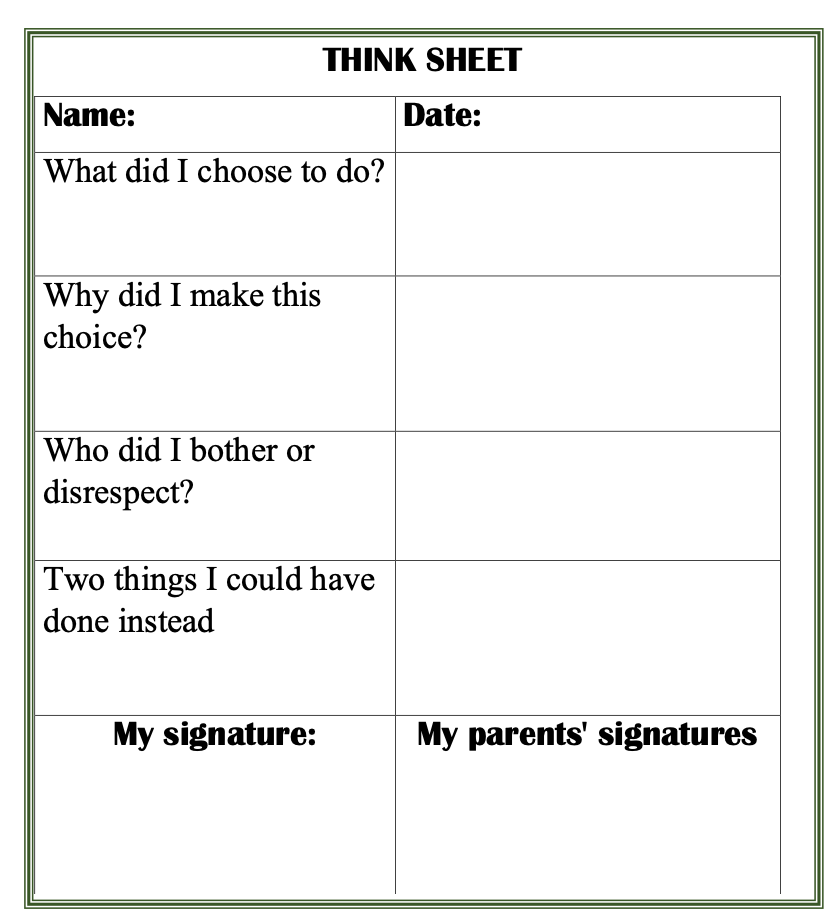
- Formative Assessment: Have students model different appropriate and inappropriate behaviour in the classroom. They discuss and reach conclusions on which norm and which consequence are applicable in those instances.
- Reflection: Why do we have norms and consequences in the class? Do I have a choice to follow them or not?
Find more scaffolds here:


Scaffoldingmagic.com is your entryway into DYNAMIC bilingual learning methodologies, such as Phenomenon-Based Learning, CLIL, EMI, and ESL. You’ll find ways to implement critical thinking tools (DOK) to promote higher level thinking, the growth mindset, instill an ethic of excellence, deep reflection on learning, and all through multi-cultural, interdisciplinary activities. We have the keys to turning competences into action and to creating collective efficacy in your school so you move ahead as a unified, enthusiastic team.

